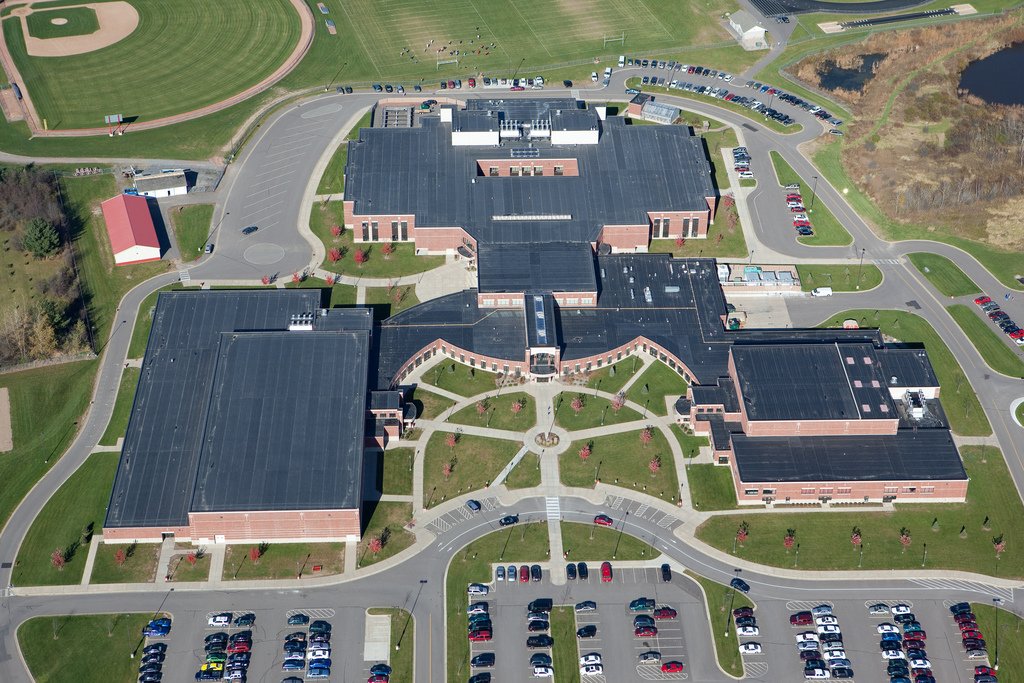What is EPDM?
The roofing industry has undergone many dramatic changes over the last twenty-five years. One of the earliest new products that caused the “industry revolution” was EPDM and this product endures today as a leading element in the market segment designated “flexible membrane roofing.” This article will examine the history of the development of this product type and some of the factors that have contributed to its long-term success.
EPDM is an elastomeric polymer synthesized from ethylene, propylene and a small amount of diene monomer. It was first introduced as a roofing material in the early 1960s. In its typical form for roofing applications, EPDM sheeting is a cured, or vulcanized, material and is thus classified as a “thermoset.” Simply defined, this means that the polymer’s molecular structure is “set” as a result of heating during the manufacturing process. The chains of the polymer are joined together, or “cross linked.” By the time the finished membrane is packaged for shipping, it is fully cured. Uncured EPDM membranes are sometimes used for flashings; but this material will eventually cure as it naturally ages under the exposure to UV light and heat. EPDM membranes can be produced in various colors (including black), non reinforced or reinforced, and in thicknesses ranging from 30 to 90 mils.
These membranes have achieved code ratings and approvals for installation in a number of different application configurations. Ballasted, fully adhered and mechanically fastened systems are all available, as are inverted membrane assemblies.
There are several reasons for the success these products have enjoyed over the years. These can be classified as material benefits, design benefits, installation benefits, and manufacturer/supplier support and stability.
Material Benefits (Weathering)
One of the most important features a roofing material must possess is the ability to retain its physical characteristics throughout its service life. EPDM compounds have been shown to exhibit a high degree of stability under conditions of exposure to ultraviolet light, ozone, and extremes of both high and low temperatures. They are resistant to some chemicals found on roofs, such as acids, alkalis, certain oils and oxygenated solvents. They are not, however, resistant to aromatic, halogenated or aliphatic solvents, or other materials such as cooking grease of animal fats. The EPDM membranes are compounded to have a high tensile strength and high elongation when not reinforced – and they are highly flexible and pliable, making them able to accommodate structural movement and high and low temperature thermal stresses.
Design Benefits
As stated, EPDM membranes may be installed in a full range of system applications. The earliest predominant design was the ballasted roof, in which the membrane is loosely laid over the substrate (usually loose laid insulation). The membrane is then covered with a layer of ballast, stone or pavers, which serve as the anchoring method that keeps the membrane in place when exposed to wind uplift forces. EPDM membranes may also be fully adhered to rigid insulation board or an appropriate structural deck. This system eliminates the weight of the ballast and leaves the membrane exposed, thus offering many opportunities for aesthetic appeal through the use of specially colored membranes and coatings or just the smooth, clean appearance of an adhered black membrane.
Many designers like the mechanically fastened system, which can utilize either an un-reinforced or reinforced EPDM membrane, because they are lightweight and easy to install. When reinforcement is added, the membrane’s resistance to tear can be increased which may be important because of dynamic loadings the membrane may experience during its life. These systems can also be very attractive in their final appearance.
The versatility in application methods has been very important to roof designers as they are able to create a design using EPDM for any roof shape, slope, height, and climatic exposures. Architectural acceptance of EPDM as a suitable roofing material has been one of this market segment’s primary reasons for success.
Application Benefits
Early in the flexible membrane market explosion, roofing contractors recognized EPDM roofing projects as a cleaner, cooler, and generally easier product to handle than the built-up roofs to which they were accustomed. With very little capital investment, roofing contractors were able to obtain all the tools and equipment needed to properly install an EPDM roof. These systems also offer low maintenance, easy repair options and low annualized cost. As with all roofing systems, careful attention to preparation and detail during installation is stressed. Many contractors have taken pride in establishing crews that specialized in the installation of EPDM membranes, thus positioning themselves to respond to owners’ and architects’ growing demand for flexible membrane systems.
Manufacturer Support and Stability
As competition in the industry intensified, one of the most often considered factors in product selection was the stability of the company supplying the product. Many of the early suppliers of EPDM roofing systems made a strong commitment to the industry by establishing extensive research and development efforts within their organizations, as well as a focus on customer support. This support took the form of contractor training, architectural specification guidance, and field support, as well as roof maintenance training for building owners. The stability of the suppliers is evidenced by the number of companies still participating in the market. Those companies that failed to provide the necessary support were unable to sustain themselves. While those that remain today have upheld integral standards of quality control, customer focus, research and development, and design support.
Rounding out the picture is the fact that EPDM has always been a competitively positioned product that has historically compared favorably against other roofing systems in terms of installation cost, availability of long term warranties and attractive life cycle cost. These features provide good reasons for the architects, installers, and building owners to continue to select EPDM roofing systems

